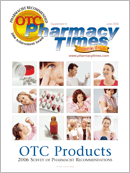Publication
Article
OTC Guide
The Facts on Plan B
Author(s):
Levonorgestrel (Plan B), a progestin-only regimen manufactured by Duramed Pharmaceuticals, a subsidiary of Barr Pharmaceuticals, is the only emergency contraceptive (EC) marketed for women in the United States. Research conducted by the World Health Organization has found that the use of the levonorgestrel EC regimen decreases the average expected pregnancy rate by as much as 85%.1
Although Plan B currently is generally available only by prescription, 7 states allow patients to obtain an EC without a prescription at some pharmacies. These states are Alaska, California, Hawaii, Maine, New Hampshire, New Mexico, and Washington. In these states, pharmacists are allowed to dispense ECs through mutual practice agreements with their local boards of pharmacy and physicians practicing in their particular state. Specific training requirements must be completed by these pharmacists in order to dispense ECs within these states.1,2
In 2003, Barr Pharmaceuticals filed a petition with the FDA for OTC approval for this agent.1 To date, no final decision has been made. Because pharmacists have a vital role in patient education, especially with regard to drug therapy, it is important that all pharmacists be prepared to effectively counsel and answer a woman's questions about this drug. Pharmacists can provide the patient with pertinent clinical information, such as its proper use and administration and potential adverse effects associated with its use, as well as contraindications.
Pharmacology of Levonorgestrel
Levonorgestrel is a synthetic progestin. It is believed to exert its therapeutic action by preventing ovulation or fertilization. In addition, it may inhibit implantation; however, it is not effective once the process of implantation has begun. Levonorgestrel is indicated for use as an EC to prevent pregnancy following unprotected intercourse or a known or suspected contraceptive failure.
The manufacturer recommends that, to obtain optimal efficacy, the first tablet (0.75 mg) should be taken as soon as possible within 72 hours of intercourse. The second tablet (0.75 mg) should be taken 12 hours later. The sooner the drug is taken, however, the more effective it is. No medical evidence shows that levonorgestrel would harm a developing fetus. As already stated, levonorgestrel will not be effective once a pregnancy is started.2
Counseling Patients Taking Levonorgestrel
When providing counseling information to women receiving levonorgestrel, it is imperative for pharmacists to relay the following key clinical information:
- The use of levonorgestrel will not protect a patient against HIV infection or any other sexually transmitted disease
- Levonorgestrel is contraindicated in women with known or suspected pregnancy or in those experiencing abnormal vaginal bleeding
- Levonorgestrel is not indicated for use as a routine contraceptive
- Again, levonorgestrel will not be effective if a woman is pregnant
- The most common adverse effects associated with the use of levonorgestrel include nausea, gastrointestinal pain, fatigue, headache, and breast tenderness
- Menstrual changes, such as heavier-or lighter-than-normal cycles, may occur. If the menses is delayed, the patient may be pregnant, so it is recommended that she consult a health care provider.
- If the patient vomits within 1 hour of taking either dose, she should consult her health care provider to discuss whether the dose needs to be repeated
- Patients with any further questions or concerns always should be directed to follow up with their primary health care provider for further evaluation
For more information on levonorgestrel, visit the manufacturer's Web site (www.go2planb.com) or the FDA Web site (www.fda.gov).
Ms. Terrie is a clinical pharmacy writer based in Haymarket, Va.
For a list of references, send a stamped, self-addressed envelope to: References Department, Attn. A. Stahl, Pharmacy Times, 241 Forsgate Drive, Jamesburg, NJ 08831; or send an e-mail request to: [email protected].
Newsletter
Stay informed on drug updates, treatment guidelines, and pharmacy practice trends—subscribe to Pharmacy Times for weekly clinical insights.







